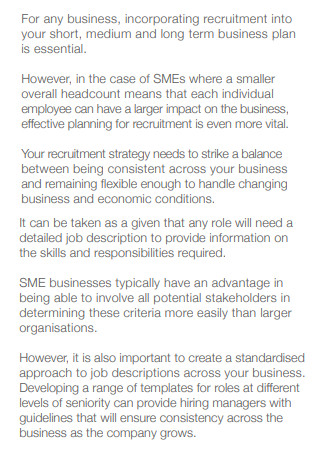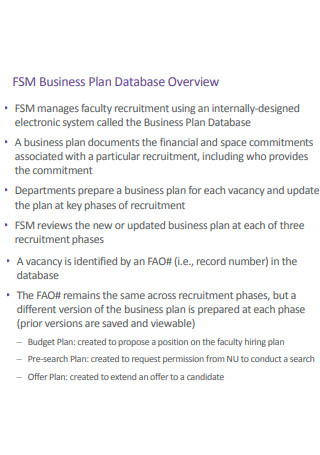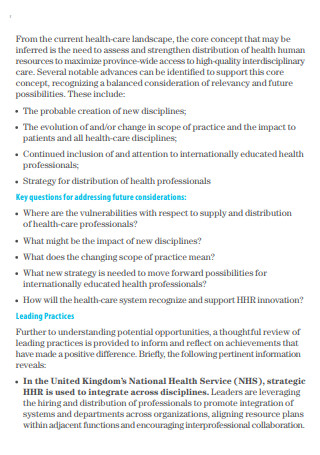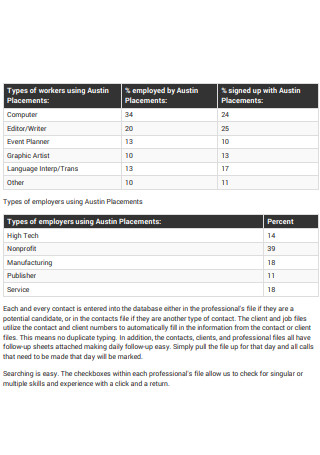3+ SAMPLE Recruitment Business Plan
FREE Recruitment Business Plan s to Download
3+ SAMPLE Recruitment Business Plan
a Recruitment Business Plan?
Benefits of Recruitment Strategy
Elements of a Successful Recruiting Strategy
How To Create a Recruitment Business Plan
FAQs
How are recruiters compensated?
Are sales more difficult than recruiting?
Which recruitment method is the most effective?
What Is a Recruitment Business Plan?
Recruitment business plans are about much more than determining which positions require immediate filling—they’re a chance to arrange company goals and skill gaps with your hiring efforts to plan for the coming year strategically. A strategic recruitment business plan should include a job list, a recruitment calendar, budget information, and tracking and assessment tools. Recruiting/staffing firms fall nicely within the category of business services. According to NYU’s Stern School of Business research, the business services industry is four times less profitable than the top twenty most profitable businesses in the United States, with a profit margin of 4.6 percent.
Benefits of Recruitment Strategy
When recruiting the ideal candidate for an open position at your company, several different recruitment strategies can be used. A targeted search is one of the most effective methods for identifying employees who will thrive in their role and contribute positively to your company culture. In essence, a targeted recruitment plan focuses advertising efforts on a specific job opening to attract individuals with specific experience levels, skill sets, personality traits, and other characteristics. We will discuss several of the primary benefits of a targeted recruitment strategy in the sections below.
Elements of a Successful Recruiting Strategy
1. Stratification of the employee base.
How many people does your business require? Additionally referred to as “workforce planning,” this feature is inherent in most effective business strategies and thus easily translated into a recruitment strategy. A business’s personnel base plan should be revised annually to allow for corporate growth for long-term success. Once you understand how many people each department needs, you can prioritize roles and make more informed investments in employee development as your firm grows.
2. Recruiter stratification
Your recruiters’ staff should be diverse in terms of skill sets and knowledge, and they should have well-defined tasks within their department. Utilizing the appropriate recruiter for a specific role ensures that the best hire is made. For instance, hiring for a highly skilled position should be handled by one or two recruiters who possess deep industry expertise to understand what questions to ask and differentiate top talent from average applications. Junior recruiters may take entry-level roles with a high volume of applicants.
3. Verification of references.
This should be self-evident, but corporations frequently neglect it, resulting in significant time, money, and wasted energy. It’s a relatively minor adjustment, but it can be the difference between employing a talented, honest, and motivated employee and choosing a fraudulent or otherwise problematic candidate. While it’s natural to be enthused about a prospect with a brilliant CV and personal charm, checking their references is just as simple and may reveal some hidden truths about your “ideal” candidate.
4. Proactive sourcing
Your recruiting team should know where to seek the most acceptable candidates for every position, beginning within your organization. With expansion at the top of the corporate goal list, it’s frequently tempting to look outside for talent. Still, the most outstanding applicants for the position may already be on staff at your organization. It is pretty inexpensive and quick to begin searching for possible candidates within your existing employee base, and once employed, they require minimal onboarding to get started. Additionally, you should constantly be establishing a talent pool comprised of seasoned, warm contacts. After internal lists, this should be your second point of contact for outreach. However, recruiting teams frequently struggle to establish this pool using standard sourcing approaches rapidly.
How To Create a Recruitment Business Plan
It’s self-evident that developing a recruitment strategy is the most excellent method to rethink and improve your hiring practices—but many businesses neglect to do so. The following are six steps to a successful recruitment business strategy to assist you in the planning process.
Step 1: Analyze recruiting requirements and skill shortages.
The first stage in developing a recruiting business plan is determining your hiring goals and any skill gaps that your current workforce cannot fill. Begin by examining your company’s growth, considering critical elements such as staff attrition and planned promotions affecting your hiring needs. Determine which departments and roles will require additional support and why. Is a vital team member departing? Is a new project about to begin? By determining which talents your team will be lacking and which ones will be required to handle increased workloads in the future, you can take a proactive strategy that better matches hiring with personnel requirements.
Step 2: Establish a hiring strategy and recruitment calendar.
Following that, you can put your study into action by estimating how many workers each department will require and when they will be required. This enables you to plan and foresee future requirements with sufficient time to prepare. For instance, if you need to fill a post in Q3, you may need to begin preparations in Q2 to ensure the position is filled on time. With this information, you may create a year-long recruitment calendar. This should include the jobs you will be hiring each quarter, the total headcount for each department, and a hiring timetable outlining when each round of hiring will commence.
Step 3: Determine the tools necessary to create a scalable recruitment process.
You can determine the tools necessary to carry out your plan now that you’ve created a recruitment calendar and a hiring strategy. The most crucial components of your recruitment technology stack are an applicant tracking system, accounts on multiple online job boards, pre-employment evaluation and screening tools, and analytics or business intelligence software for data-driven decision-making. These tools will assist your team in organizing and streamlining the hiring process by automating time-consuming procedures and streamlining the candidate screening process. Additionally, you can optimize your talent pool by gathering data on your applicants’ profiles and comparing them to the profiles of your top performers. With our evaluation tool, you can quickly discover which applicants have similar ratings and gain insight into your whole recruitment funnel.
Step 4: Determine the qualifications required for each role.
With a firm grasp on the roles for which you’ll be recruiting, you can begin defining the qualifications for each job vacancy. To ensure that everyone is on the corresponding page and speed up the hiring process, you should meet with hiring managers and discuss this stage jointly. This will assist you in developing a complete understanding of each function and the requirements for efficiently filling it. For instance, if you’re recruiting for a contact center, you may wish to hire individuals with transferrable abilities if you need to transition personnel from chat agent to phone agent roles. To do this effectively and efficiently, you must go beyond current positions and consider your company culture and the general qualities that candidates should possess to be a good fit. Rather than recruiting solely qualified applicants for a specific job, you examine candidates’ abilities and attributes and give them jobs that suit their best skill set.
Step 5: Begin with an enticing job description.
Attracting the most qualified individuals begins with a compelling job description. However, many businesses take the wrong approach. They detail the job’s particular criteria and expectations but mention the company’s benefits, which may discourage job seekers from applying. Avoid this error and instead strive to design job descriptions that are interesting, inclusive, and appealing to job searchers. They should include information about your organization’s mission and beliefs, as well as job analysis. Do not be afraid to demonstrate some personality—remember, job descriptions serve as an opportunity to market the position to prospective candidates.
Step 6: Establish a procedure for applicant selection.
Following that, you should consider how you would approach the hard work of candidate selection. Define the overall process clearly by establishing the number of interview rounds and who will be responsible for interviewing and selecting candidates. You should avoid employing a one-size-fits-all selection procedure when selecting individuals. Instead of that, you should seek out unique ways to tailor the experience to each individual. This can be accomplished by anticipating and answering any questions, needs, or concerns throughout the interview and selection process. Assessments come in various forms, from testing abilities and personality to determining cognitive capacity and cultural compatibility. Using a customizable pre-hire assessment tool, you may develop gamified online exams to aid candidate selection and engagement.
FAQs
How are recruiters compensated?
Most agency recruiters earn a base salary and are compensated on a commission basis for putting prospects with the companies for whom they recruit. When an agency recruiter places a candidate on a contingency basis for direct employment, the recruiter is compensated on a percentage depending on the job seeker’s first-year compensation.
Are sales more difficult than recruiting?
Recruiting is a type of sales and one of the most demanding. There are, however, numerous distinctions between recruitment and pure sales. Someone who has spent their entire career selling automobiles cannot suddenly find success as a recruiter.
Which recruitment method is the most effective?
One of the most dominant recruiting strategies is to treat candidates similarly to how you treat your clients. Be considerate of their time. Always arrive on time, whether it’s a phone or email conversation, video conference, or in-person meeting. If you anticipate being late, notify the candidate as soon as feasible.
A recruitment business strategy should serve as the guiding light for all of your recruitment operations. It may take time and work to develop one; but, do not believe that once completed, it is definitive. You should change and optimize your plan in response to the business’s changing needs throughout time. For instance, what if your business grows quicker than anticipated and you find yourself needing to hire more personnel than anticipated? Alternatively, what if you decide to deploy a whole new technology? Please continue to work on your recruitment business plan, tracking essential metrics and iteratively improving them to reach the best results possible.




